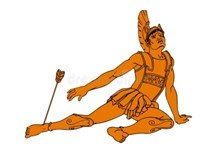
All News
Daily Bridge in New Zealand

Michaels Achilles.
Most players use some form of Michaels Cue Bids even if it is only jumping to 2NT to show length in both minor suits. It can be really handy to identify two suits in one bid. We like both suits to be of at least 5-cards long as the bidder pushes the auction to a relatively high level by the bid. We can show less distributional hands by doubling…or alternatively by simply bidding one’s longest suit.
Such two-suited bids are most effective when the side which makes the Michaels bid ends as the declaring side. When the player who makes the bid ends as a defender, the declarer has a lot of information about the shape of the defenders’ hands. That can be extremely useful and should have helped the declarer on the board below.


|
West Deals |
|
||||||||||||||
|
|
|
|
|||||||||||||
|
|||||||||||||||
|
West |
North |
East |
South |
|
Pass |
1 ♦ |
2 NT |
3 ♠ |
|
4 ♥ |
4 ♠ |
5 ♥ |
5 ♠ |
|
All pass |
|
|
|
East’s 2NT showed the lower two unbid suits, hearts and clubs. South bid what they had but the auction was quickly back to them at the 5-level. Perhaps they should have left the final decision at the 5-level to their partner but with no defence to either of East’s suits, they elected to bid on.
West led ![]() 8. Plan the play. A second round of trumps would reveal that West had started with three trumps.
8. Plan the play. A second round of trumps would reveal that West had started with three trumps.
With an aim of getting 11 tricks and without any opposition bidding, declarer might be excused for drawing trumps and taking the diamond finesse. East might have a large number of diamonds and even give their partner a third round ruff if West was left a trump when the diamond finesse was taken.
However, South knew that could not be the case here because of the Michaels bid. Yet, our declarer was careless in the play. They won the ![]() A at trick 1, recognising that the lead just had to be a singleton (East had shown at least 5) and cashed the
A at trick 1, recognising that the lead just had to be a singleton (East had shown at least 5) and cashed the ![]() A just in case East held the singleton
A just in case East held the singleton ![]() Q. They did not.
Q. They did not.
Thinking then that the success of the contract depended on a successful diamond finesse (it did), they drew three rounds of trumps before playing ![]() 10 from hand. They felt good for a second when West produced
10 from hand. They felt good for a second when West produced ![]() Q but the joy turned to anguish when East discarded a heart:
Q but the joy turned to anguish when East discarded a heart:
|
West Deals |
|
||||||||||||||||||||||||||||||
|
|
|
|||||||||||||||||||||||||||||
|
|||||||||||||||||||||||||||||||
|
West |
North |
East |
South |
|
Pass |
1 ♦ |
2 NT |
3 ♠ |
|
4 ♥ |
4 ♠ |
5 ♥ |
5 ♠ |
|
All pass |
|
|
|
Although there was no diamond loser, South could not discard any of their three losers on diamonds and had to concede for one down.
South knew East had at least five hearts and five clubs. On a bad day, East would be 5-5 with the doubleton ![]() Q, unlucky. Yet, either East or West held six hearts and it could well be East after they could not follow to the second round of trumps.
Q, unlucky. Yet, either East or West held six hearts and it could well be East after they could not follow to the second round of trumps.
South was correct in drawing two rounds of trumps but there was no rush, no danger in not drawing West’s last trump just yet. East could not have more than two diamonds. Their Michaels bid said so. Thus, after the second round of diamonds, South should have taken a successful diamond finesse. It did not matter which diamond South played as West would have covered their card. Then, as East discarded, South could play dummy’s other high diamond, ruff the fourth round of the suit with West following and then play a low spade to ![]() 10 in dummy (that card should still be in dummy) before discarding one of their three losers on the 5th round of diamonds to make their contract.
10 in dummy (that card should still be in dummy) before discarding one of their three losers on the 5th round of diamonds to make their contract.
Not drawing the third round of trumps was a sensible approach anyway but knowing East’s shape (within one card) made it absolutely safe and indeed necessary not to do so.
Richard Solomon
Go Back View All News Items
